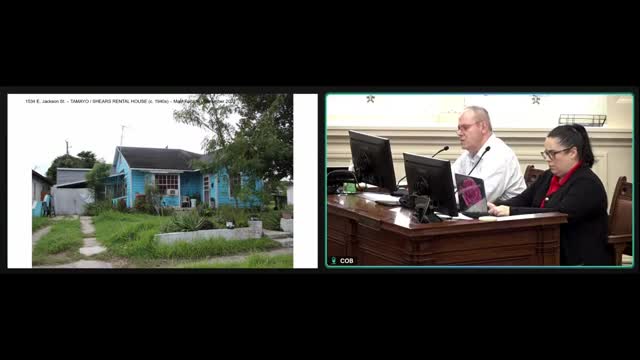Historic Preservation Commission reviews demolition and renovation plans for local property
March 27, 2025 | Brownsville, Cameron County, Texas
This article was created by AI summarizing key points discussed. AI makes mistakes, so for full details and context, please refer to the video of the full meeting. Please report any errors so we can fix them. Report an error »

In a recent meeting of the Architectural Review Committee in Brownsville, Texas, members gathered to discuss significant renovations and demolitions aimed at preserving the historical integrity of local properties. The atmosphere was charged with a sense of responsibility as committee members reviewed plans that would reshape the neighborhood while honoring its past.
One of the primary projects under consideration involved the demolition of an addition to a historic home, returning it to its original floor plan. The proposed changes included removing a wall between the living room and kitchen to create a more open space, while maintaining the overall structure of the house. The committee emphasized the importance of preserving original features, such as the fireplace and traditional siding, while also updating elements like windows and doors to align with historical standards.
As the discussion progressed, the committee examined a second project concerning a newly proposed structure on a previously vacant lot. The owners had amended their original design to comply with city ordinances, creating larger spaces and ensuring proper alignment with neighboring buildings. The new plans featured a side entrance to maximize usable space, demonstrating a thoughtful approach to modern living while respecting the architectural character of the area.
Throughout the meeting, members expressed a preference for durable materials, suggesting the use of hardy plank siding over traditional wood to mitigate issues with pests, particularly termites. This practical consideration highlighted the committee's commitment to balancing aesthetic appeal with long-term sustainability.
After thorough deliberation, the committee voted unanimously to recommend both projects to the city council, signaling a step forward in the ongoing effort to enhance Brownsville's architectural landscape. As the meeting concluded, the members left with a sense of accomplishment, knowing their decisions would contribute to the preservation and revitalization of the community's historical charm.
One of the primary projects under consideration involved the demolition of an addition to a historic home, returning it to its original floor plan. The proposed changes included removing a wall between the living room and kitchen to create a more open space, while maintaining the overall structure of the house. The committee emphasized the importance of preserving original features, such as the fireplace and traditional siding, while also updating elements like windows and doors to align with historical standards.
As the discussion progressed, the committee examined a second project concerning a newly proposed structure on a previously vacant lot. The owners had amended their original design to comply with city ordinances, creating larger spaces and ensuring proper alignment with neighboring buildings. The new plans featured a side entrance to maximize usable space, demonstrating a thoughtful approach to modern living while respecting the architectural character of the area.
Throughout the meeting, members expressed a preference for durable materials, suggesting the use of hardy plank siding over traditional wood to mitigate issues with pests, particularly termites. This practical consideration highlighted the committee's commitment to balancing aesthetic appeal with long-term sustainability.
After thorough deliberation, the committee voted unanimously to recommend both projects to the city council, signaling a step forward in the ongoing effort to enhance Brownsville's architectural landscape. As the meeting concluded, the members left with a sense of accomplishment, knowing their decisions would contribute to the preservation and revitalization of the community's historical charm.
View full meeting
This article is based on a recent meeting—watch the full video and explore the complete transcript for deeper insights into the discussion.
View full meeting
